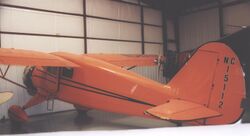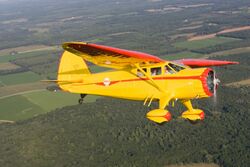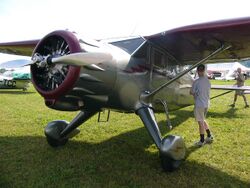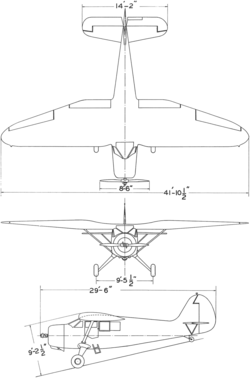Engineering:Stinson Reliant
The Stinson Reliant is a popular single-engine four- to five-seat high-wing monoplane manufactured by the Stinson Aircraft Division of the Aviation Manufacturing Corporation of Wayne, Michigan.
Design and development
The Reliant is a high-wing, fixed-tailwheel land monoplane powered with a variety of radial engines.[1]
1,327 Reliants of all types were made from 1933 to 1941, in different models, from SR-1 to SR-10. The final commercial model, the Stinson Reliant SR-10, was introduced in 1938. A militarized version was first flown in February 1942 and remained in production through several additional versions (all externally identical) until late 1943 for the US and British armed forces.[citation needed]
Reliant production can be broken into two distinct types – the straight-wing Reliants (all models up to SR-6) and the gull-wing Reliants (all models from SR-7 and after, including the militarized V-77/AT-19), with there being little in common between the two groups of types. The straight-wing Reliant has a wing of constant chord and thickness which is supported by two struts each side with additional bracing struts. In contrast the taper-wing Reliant has the broadest chord and thickness of the wing at mid-span, with the outer wing trailing edge heavily angled forward and a rounded cutout on the leading edge root, all supported by a single strut. The taper wing has a significant step up between the fuselage and the wing, and the changes in wing thickness gave it a distinct gull appearance from the front.[citation needed]
Operational history
The Reliant was used by the United States Army Air Forces in World War II as a utility aircraft, designated UC-81, and as trainer designated AT-19. The Royal Navy and Royal Air Force also used Reliants, for light transport and communication duties. After the war they were sold on the civilian market as the Vultee V-77.
The V-77 is a spartan version of the SR-10 with the 300 hp Lycoming R680-E3B, a single door on the left side and the traditional "bump" cowl was replaced with a simpler smooth cowl. Internal structure was beefed up significantly over the commercial models, and a distinctive triangle-shaped counterbalance was added to the rudder.[citation needed]
Variants
The SR-10 Reliant was available as a landplane, seaplane and skidplane in the following configurations:[2]
- Ambulance (two stretchers)
- Cargo/Ambulance
- Target Towing
- Firefighting
- Photographic
Civilian variants
- SR Reliant: Powered by a 215 hp (160 kW) Lycoming R-680 radial piston engine.[3]
- SR-1: Powered by a 240 hp (180 kW) Lycoming R-680-2 radial piston engine. Two built.[4]
- SR-2: Powered by a 240-hp (179-kW) Lycoming R-680-7 radial piston engine.
- SR-3: Similar to the SR-1, but with minor structural changes.
- SR-4: Powered by a 250-hp (186-kW) Wright R-760-E radial piston engine.
- SR-5: Improved version, powered by a 225-hp (168-kW) Lycoming R-680-4 radial piston engine.
- SR-5A: Powered by a 245-hp (183-kW) Lycoming R-680-6 radial piston engine.
- SR-5B: Powered by a 240-hp (179-kW) Lycoming R-680-2 radial piston engine.
- SR-5C: Powered by a 260-hp (194-kW) Lycoming R-680-5 radial piston engine.
- SR-5E: Powered by a 225-hp (168-kW) Lycoming R-680-4 radial piston engine.
- SR-5F: Powered by a 250-hp (186-kW) Wright R-760-E radial piston engine.
- SR-6: Four-seat cabin aircraft, powered by a Lycoming R-680-6 radial piston engine.
- SR-6A: Four-seat cabin aircraft, powered by a 225-hp (168-kW) Lycoming R-680-4 radial piston engine.
- SR-6B: Four-seat cabin aircraft, powered by a Lycoming R-680-5 radial piston engine.
- SR-7: First gull wing series.
- SR-7B: Four-seat cabin aircraft, powered by a Lycoming R-680-B6 radial piston engine. 47 built.[5]
- SR-7C: Four-seat cabin aircraft, powered by a Lycoming R-680-B5 radial piston engine. Three built.[5]
- SR-8A: Five-seat cabin aircraft.
- SR-8B: Five-seat cabin aircraft, powered by a Lycoming R-680-B6 radial piston engine.
- SR-8C: Five-seat cabin aircraft, powered by a Lycoming R-680-B5 radial piston engine.
- SR-8D: Five-seat cabin aircraft, powered by a Wright R-760-E2 radial piston engine.
- SR-8DM: Utility transport version of the SR-8D.
- SR-8E: Five-seat cabin aircraft, powered by a 320-hp (239-kW) Wright R-760-E23 radial piston engine.
- SR-8DE: Utility transport version of the SR-8E.
- SR-9: 1937 series. Fitted with a curved windshield, unique to this series.[6]
- SR-9A: Proposed version with Lycoming R-680-B4 engine. Unbuilt.[6]
- SR-9B: Powered by a 245 horsepower (183 kW) Lycoming R-680-B6 engine. 35 built.[6][7]
- SR-9C: Powered by a 260 horsepower (190 kW) Lycoming R-680-B5 engine. 65 built.[6][7]
- SR-9D: Powered by a 285 horsepower (213 kW) Wright R-760-E1 engine. 22 built.[6][7]
- SR-9E: Powered by a 320 horsepower (240 kW) Wright R-760-E2 engine. 43 built.[6][7]
- SR-9F: Powered by a 450 horsepower (340 kW) Pratt & Whitney Wasp Junior radial engine. 34 built.[6]
- SR-10
- SR-10B: Powered by a Lycoming R-680-D6. One built.[6]
- SR-10C: Powered by a Lycoming R-680-D5 engine. 46 built.[6]
- SR-10D: Wright R-760E-1 engine. 3 built.[8]
- SR-10E: Powered by a Wright R-760E-2 radial piston engine. 21 built.[8]
- SR-10F: Powered by a Pratt & Whitney R-985 Wasp Junior SB radial piston engine. 18 built.[9]
- SR-10G: Powered by a Lycoming R-680-E1 radial piston engine. 12 built.[6]
- SR-10J: Lycoming R-680-E3 engine. 11 built.[6]
- SR-10K: Powered by a 450 horsepower (340 kW) Wright R-975E-3 radial engine. 2 built for New York City Police Department; one with conventional landing gear, one seaplane with Edo floats.[6][10]
Military variants
- AT-19
- USAAF designation for a training variant of the UC-81 for the Royal Navy under Lend-Lease as the Reliant I, 500 built.[11]
- AT-19A
- Original designation of the L-9A which was a Voyager not a Reliant.[11]
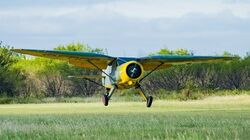
- AT-19B
- Original designation of the L-9B which was a Voyager not a Reliant.[11]
- AT-19C
- Conversions of AT-19s for photo-survey aircraft for the USAAF, 51 conversions.[11]
- UC-81
- Four impressed SR.8Bs.[13]
- UC-81A
- Two impressed SR.10Gs.[13]
- UC-81B
- One impressed SR.8E.[13]
- UC-81C
- Three impressed SR.9Cs.[13]
- XC-81D
- One civil SR.10F operated by the military for the development of glider pick-up techniques.[13]
- UC-81E
- Four impressed SR.9Fs.[13]
- UC-81F
- Seven impressed SR.10Fs.[13]
- UC-81G
- Three impressed SR.9Ds.[13]
- UC-81H
- One impressed SR.10E.[13]
- UC-81J
- Nine impressed SR.9Es.[13]
- UC-81K
- Five impressed SR.10Cs.[13]
- UC-81L
- Two impressed SR.8Cs.[13]
- UC-81M
- One impressed SR.9EM.[13]
- UC-81N
- Two impressed SR.9Bs.[13]
- L-12
- Two SR.5As impressed into service with the USAAF during World War II.[14]
- L-12A
- Two SR.7Bs impressed into service during World War II.[14]
- RQ-1
- One SR-5 Reliant was acquired by the US Coast Guard in 1935, later redesignated XR3Q-1 and decommissioned in 1941.[15]
- XR3Q-1
- One SR-5 Reliant was acquired by the US Navy in 1935.[16]
- Reliant I
- 500 Reliants were supplied to the Royal Navy under Lend-Lease. The Reliants were used for light transport and communications, navigation and radio training duties.
Operators
Military operators
 Argentina
Argentina
- Argentine Navy[9]
 Australia
Australia
 United Kingdom
United Kingdom
- Royal Air Force
- No. 510 Squadron RAF[18]
- Fleet Air Arm
- 730 Naval Air Squadron
- 748 Naval Air Squadron
 Uruguay
Uruguay
 United States
United States
- United States Army Air Forces – A total of 47 Reliants impressed during World War 2[20]
- United States Coast Guard[15]
- United States Navy[9]
Civil operators
 Brazil
Brazil
- Aerolloyd Iguassu
- Aerovias Minas Gerais
- NAB – Navegação Aérea Brasileira
 El Salvador
El Salvador
- Grupo TACA
 Mexico
Mexico
- Aeronaves de México – the Reliant was the first aircraft used by Aeronaves, later to become Mexico's largest airline, Aeromexico, on their initial service between Mexico and Acapulco on 14 September 1934[21]
 Norway
Norway
- Widerøe
 Paraguay
Paraguay
- Líneas Aéreas de Transporte Nacional (LATN)
 United States
United States
- New York City Police Department Aviation Unit
- Northwest Airways
Specifications (SR-10F)
Data from General Dynamics Aircraft and their Predecessors[9]
General characteristics
- Crew: one, pilot
- Capacity: 3 to 4 passengers
- Length: 27 ft 11 in (8.51 m)
- Wingspan: 41 ft 7 in (12.68 m)
- Height: 8 ft 6 in (2.59 m)
- Wing area: 256.5 sq ft (23.84 m2)
- Empty weight: 3,045 lb (1,384 kg)
- Gross weight: 4,605 lb (2,093 kg)
- Powerplant: 1 × Pratt & Whitney Wasp Junior SB nine-cylinder air-cooled radial engine, 400 hp (298 kW)
Performance
- Cruise speed: 154 kn (177 mph, 285 km/h)
- Range: 739 nmi (850 mi, 1,369 km)
- Service ceiling: 21,000 ft (6,400 m)
- Rate of climb: 1,330 ft/min (6.8 m/s)
See also
Aircraft of comparable role, configuration and era
- Cessna Airmaster
- de Havilland Canada DHC-2 Beaver
- Fairchild 24
- Howard DGA-15
- Monocoupe 90
- Noorduyn Norseman
- Waco Standard Cabin series
Related lists
- List of aircraft of the Fleet Air Arm
- List of aircraft of the Royal Air Force
- List of aircraft of the United States during World War II
- List of aircraft of World War II
- List of military aircraft of the United States
- List of United States Navy aircraft designations (pre-1962)
References
- ↑ Pilot's Flight Operating Instructions for Army Model AT-19 Airplanes and British Model Reliant – 15 June 1944
- ↑ Stinson SR-10 Specifications – April 1940
- ↑ Wegg 1990, pp. 131, 133.
- ↑ Wegg 1990, p. 132.
- ↑ 5.0 5.1 Wegg 1990, p. 135.
- ↑ 6.00 6.01 6.02 6.03 6.04 6.05 6.06 6.07 6.08 6.09 6.10 6.11 Wegg 1990, p. 136.
- ↑ 7.0 7.1 7.2 7.3 Aviation February 1937, p. 36.
- ↑ 8.0 8.1 Wegg 1990, pp. 136–137.
- ↑ 9.0 9.1 9.2 9.3 Wegg 1990, p. 137.
- ↑ "FAA Aircraft Type Certificate 679". Federal Aviation Administration. https://rgl.faa.gov/Regulatory_and_Guidance_Library/rgMakeModel.nsf/0/a5395a43a85557cf8525673e0056534d/$FILE/TC679.pdf.
- ↑ 11.0 11.1 11.2 11.3 Andrade 1979, p.79
- ↑ "AT-19B – Texas Air Museum" (in en-US). https://thetexasairmuseum.org/at-19b/.
- ↑ 13.00 13.01 13.02 13.03 13.04 13.05 13.06 13.07 13.08 13.09 13.10 13.11 13.12 13.13 Andrade 1979, p.81
- ↑ 14.0 14.1 Andrade 1979, p.130
- ↑ 15.0 15.1 Pearcy 1991, p. 317.
- ↑ "A38 Stinson Reliant". RAAF Museum. 2009. http://www.airforce.gov.au/raafmuseum/research/aircraft/series2/A38.htm.
- ↑ Halley 1980, p. 306.
- ↑ "Memorias del Tiempo de Vuelo / Stinson SR-7A Reliant". http://www.pilotoviejo.com/stinsonreliant.htm.
- ↑ Swanborough and Bowers 1963, p. 532.
- ↑ Aeromexico – The Story of a Great Company, last accessed on 2012 November 30
Bibliography
- Andrade, John (1979). U.S. Military Aircraft Designations and Serials since 1909. Midland Counties Publications. ISBN 0-904597-22-9.
- Elliot, Bryn (March–April 1997). "Bears in the Air: The US Air Police Perspective". Air Enthusiast (68): 46–51. ISSN 0143-5450.
- Halley, James J (1980). The Squadrons of the Royal Air Force. Tonbridge, Kent, UK: Air Britain (Historians). ISBN 0-85130-083-9.
- Pearcy, Arthur (1991). U.S. Coast Guard Aircraft Since 1916. Shrewsbury, UK: Airlife Publishing. ISBN 1-85310-118-4.
- Sapienza, Antonio Luis (June 2000). "Les premiers avions de transport commercial au Paraguay" (in fr). Avions: Toute l'Aéronautique et son histoire (87): 45–47. ISSN 1243-8650.
- "Stinson Restyles". Aviation Week & Space Technology 36 (2): 35–36. February 1937. http://archive.aviationweek.com/issue/19370201#!&pid=34.
- Swanborough, F. G.; Bowers, Peter M. (1963). United States Military Aircraft since 1909. London: Putnam.
- Swanborough, Gordon; Bowers, Peter M. (1976). United States Navy Aircraft since 1911 (Second ed.). London: Putnam. ISBN 0-370-10054-9.
- Wegg, John (1990). General Dynamics Aircraft and their Predecessors. London: Putnam. ISBN 0-85177-833-X.
External links
- Stinson SR-10F Reliant National Air and Space Museum, Smithsonian Institution
- Stinson UC-81 Reliant (Stinson AT-19/SR-10) Fleet Air Arm Archive
- Stinson SR-9 Alberta Aviation Museum
- (1944) T.O. No. 01-50KA-1 Pilot's Flight Operating Instructions for Army Model AT-19 Airplanes, British Model Reliant
 |


